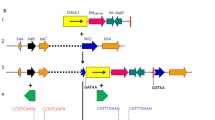Abstract
The aim of this work was to study the phenotypic and molecular characterization of a novel plasmid-mediated AmpC β-lactamase from Escherichia coli E384. Conjugation experiments, isoelectric focusing, pulsed-field gel electrophoresis, plasmid profiling, and Southern blot as well as PCR, sequencing techniques, and susceptibility testing were carried out to investigate the underlying mechanism of resistance. The kinetic parameters were determined to characterize the novel enzyme. MIR-4 β-lactamase, pI 8.2, is a novel variant with four substitutions of amino acids compared with the sequence of MIR-1. E. coli E384 displays resistance to eight β-lactam antimicrobial agents and three fluoroquinolones. The minimal inhibitory concentrations of β-lactam in combination with β-lactamase inhibitors show no significant synergy. Kinetic parameters suggest that the novel enzyme effectively hydrolyzes broad-spectrum β-lactams. The same hybridization signal was detectable only in the 54-kb plasmid band that hybridized with the bla CTX-M- and bla ampC-specific probes. This is the first description of a plasmid-mediated MIR-4 enzyme in China. This study illustrates the importance of molecular surveillance in tracking AmpC-producing strains at general hospitals and emphasizes the need for epidemiological monitoring.

Similar content being viewed by others
References
Alvarez M, Tran JH, Chow N et al (2004) Epidemiology of conjugative plasmid-mediated AmpC beta-lactamases in the United States. Antimicrob Agents Chemother 48:533–537
Ambler RP (1980) The structure of beta-lactamases. Philos Trans R Soc Lond B Biol Sci 289:321–331
Bauernfeind A, Chong Y, Lee K (1998) Plasmid-encoded AmpC beta-lactamases: how far have we gone 10 years after their discovery? Yonsei Med J 39:520–525
Bonnet R, Dutour C, Sampaio JL et al (2001) Novel cefotaximase (CTX-M-16) with increased catalytic efficiency due to substitution Asp–240 → Gly. Antimicrob Agents Chemother 45:2269–2275
Bradford PA, Urban C, Mariano N et al (1997) Imipenem resistance in Klebsiella pneumoniae is associated with the combination of ACT-1, a plasmid-mediated AmpC beta-lactamase, and the loss of an outer membrane protein. Antimicrob Agents Chemother 41:563–569
Bush K, Jacoby GA, Medeiros AA (1995) A functional classification scheme for beta-lactamases and its correlation with molecular structure. Antimicrob Agents Chemother 39:1211–1233
Chanal C, Sirot D, Romaszko JP et al (1996) Survey of prevalence of extended-spectrum beta-lactamases among Enterobacteriaceae. J Antimicrobial Chemotherapy 38:127–132
Cheng J, Ye Y, Wang YY et al (2008) Phenotypic and molecular characterization of 5 novel CTX-M enzymes carried by Klebsiella pneumoniae and Escherichia coli. Acta Pharmacol Sin 29:217–225
Clinical and Laboratory Standards Institute/NCCLS (2005) Performance standards for antimicrobial susceptibility testing; fifteenth informational supplement. CLSI/NCCLS Document M100-S15 25:1–167
Dunne EF, Fey PD, Kludt P et al (2000) Emergence of domestically acquired ceftriaxone-resistant Salmonella infections associated with AmpC beta-lactamase. JAMA 284:3151–3156
Gazouli M, Kaufmann ME, Tzelepi E et al (1997) Study of an outbreak of cefoxitin-resistant Klebsiella pneumoniae in a general hospital. J Clin Microbiol 35:508–510
Ghuysen JM (1991) Serine beta-lactamases and penicillin-binding proteins. Annu Rev Microbiol 45:37–67
Ishii Y, Ohno A, Taguchi H et al (1995) Cloning and sequence of the gene encoding a cefotaxime-hydrolyzing class A beta-lactamase isolated from Escherichia coli. Antimicrob Agents Chemother 39:2269–2275
Jenks PJ, Hu YM, Danel F et al (1995) Plasmid-mediated production of class I (AmpC) beta-lactamase by two Klebsiella pneumoniae isolates from the UK. J Antimicrob Chemother 35:235–236
Jones RN (1998) Important and emerging beta-lactamase-mediated resistances in hospital-based pathogens:the AmpC enzymes. Diagn Microbiol Infect Dis 31:461–466
Kado CI, Liu ST (1981) Rapid procedure for detection and isolation of large and small plasmids. J Bacteriol 145:1365–1373
Papanicolaou GA, Medeiros AA, Jacoby GA (1990) Novel plasmid-mediated beta-lactamase (MIR-1) conferring resistance to oxyimino- and α-methoxy β-lactams in clinical isolates of Klebsiella pneumoniae. Antimicrob Agents Chemother 34:2200–2209
Pechere JC, Guay R, Dubois J et al (1980) Hydrolysis of cefotaxime by a beta-lactamase from Bacteroides fragilis. Antimicrob Agents Chemother 17:1001–1003
Philippon A, Arlet G, Jacoby GA (2002) Plasmid-determined AmpC-type beta-Lactamases. Antimicrob Agents Chemother 46:1–11
Stapleton PD, Shannon KP, French GL (1999) Carbapenem resistance in Escherichia coli associated with plasmid-determined CMY-4 beta-lactamase production and loss of an outer membrane protein. Antimicrob Agents Chemother 43:1206–1210
Yan JJ, Wu SM, Tsai SH et al (2000) Prevalence of SHV-12 among clinical isolates of Klebsiella pneumoniae producing extended-spectrum beta-lactamases and identification of a novel AmpC enzyme (CMY-8) in southern Taiwan. Antimicrob Agents Chemother 44:1438–1442
Acknowledgments
This work was supported by the National Natural Science Foundation of China (No. 30772286) and Anhui Natural Science Foundation (No. 070413110). We thank Professor Guang-He Fei for critical reading of the manuscript.
Author information
Authors and Affiliations
Corresponding authors
Additional information
Qian Wang and Jun Cheng contributed equally to this work.
Rights and permissions
About this article
Cite this article
Wang, Q., Cheng, J., Chen, Y. et al. Characterization of a Novel AmpC-Type Plasmid-Mediated β-Lactamase from an Escherichia coli Strain Isolated in China. Curr Microbiol 57, 558–563 (2008). https://doi.org/10.1007/s00284-008-9242-5
Received:
Revised:
Accepted:
Published:
Issue Date:
DOI: https://doi.org/10.1007/s00284-008-9242-5




